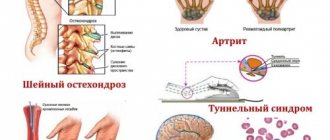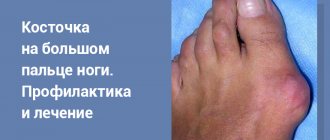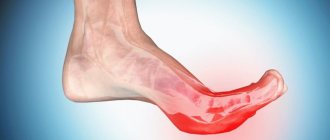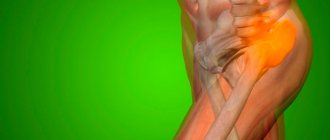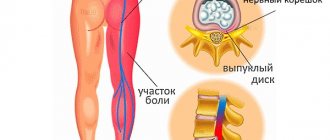The problem of swelling of the legs is familiar to every person. It often goes away on its own after the legs have been given a good rest. In women, the main cause of leg swelling is associated with wearing high-heeled shoes. Unfortunately, the problem is not always so harmless. Regular swelling accompanied by pain is a cause for concern. Such alarming symptoms may be a sign of the onset of a pathological process.
Why legs swell: causes of leg swelling
- Varicose veins are the main and most common cause of leg swelling. Varicose veins are dilation of the superficial veins of the lower extremities, accompanied by valve incompetence and impaired blood flow. The most dangerous cause of edema is the formation of blood clots.
- Heart problems can be another cause of swollen feet.
- Diseases of the kidneys and adrenal glands are also among the reasons why legs swell. Moreover, with such diseases, swelling appears on both the face and hands.
- Malfunctions of the thyroid gland , for example, disruption of the female genital organs and adrenal glands, also cause swelling of the legs.
- Liver diseases
- Diabetes
- Excess weight . Needless to say, overweight people have constant stress on their legs, which leads to swelling.
- Pregnancy - during this period, swelling of the legs occurs due to increased stress on the legs, as well as due to hormonal changes. Some women experience swelling in their legs while taking birth control medications.
Decongestant recipes
You can remove swelling with flaxseeds. You need to take 2 tbsp. l. raw materials and pour 1 liter of boiling water over them. Then the container is put on fire until it boils. The product is cooked for 20 minutes. Then it cools and strains.
The decoction is consumed in 100 ml doses at intervals of 2 hours. The course of treatment is two weeks. For taste, you can add freshly squeezed fruit juice to the product. Other recipes:
- An infusion is made from parsley. Take 1 tbsp. l. crushed plant into pulp and pour 200 ml of boiling water into a thermos. The product is infused overnight, filtered and consumed 1 tbsp. l. at intervals of 1 hour. The duration of treatment is three days. For taste, you can add a little lemon juice to the infusion.
- Take 1 tbsp. l. dry hawthorn inflorescences and its fruits. They are filled with 500 ml of boiling water. The container is covered with a lid and the product is infused for 30 minutes. Then it is filtered and consumed three times a day, 1/3 tbsp.
- Take 1 tbsp. l. corn silk and St. John's wort, 1 tsp each. - adonis, motherwort, as well as the same amount of calendula and valerian. All ingredients are mixed and poured into 1 liter. boiling water The product is infused for about an hour, then a little natural honey is added to it. The medicine must be taken daily in five doses.
- For a wine-honey drink, take red wine and natural honey in a 2:1 ratio. Then the product is stirred until the beekeeping product is completely dissolved. The finished drink should be drunk 50 ml 3 times a day, before meals.
- To prepare a cocktail from different juices, take lemon, cucumber and carrot in equal proportions. They are mixed and divided into three parts, which are drunk at short intervals throughout the day. Before use, each portion is slightly diluted with water. You should drink the cocktail until the swelling disappears.
- Take dried crushed birch leaves or birch buds and pour 100 ml of boiling water. The product is infused for 20 minutes, then filtered and divided into three equal parts. The entire volume is drunk a day, in 3 doses, before meals. The duration of treatment is up to a month.
- As a drink for swelling, birch tea helps a lot. To prepare tea from this tree, take 1 tbsp. l. crushed leaves and brewed in a glass of boiling water. Let the product brew for 30-60 minutes.
- Watermelon rinds are finely crushed and filled with water in a ratio of 1:10. Then the container is placed on the fire and the liquid is brought to a boil. The product is cooked for 20 minutes. Strain and drink 100 ml 4 times a day. The product should be drunk until the swelling disappears completely.
- In 1 l. boiling water is added 4 tsp. melon seeds. The container is closed with a lid and left for 15 minutes, then in an open container for another hour. The product is filtered and taken in 125 ml doses in 6 doses.
- Take 2 tbsp. l. chopped parsley seeds and pour 1 liter. water. The product is infused overnight, filtered and consumed three times a day, 3 tbsp. l. The course of treatment is up to 2 weeks.
- For the corn silk product, take 1 tbsp. l. fibers and pour in 200 ml of boiling water. The product is kept for 5 minutes and then filtered. The infusion should be taken in a glass three times a day. However, the product is not recommended for people with heart disease. Also, this medicine can upset the salt balance.
An infusion of cornflower flowers gives good results. Take 1 tsp. dried raw materials and pour 200 ml of boiling water. The product is infused for an hour, filtered and taken 20 minutes before meals, 3 times a day, 2 tbsp. l. The duration of treatment is until the swelling disappears completely.
We will separately highlight bad habits that cause swelling of the legs
1. Sit in one position for a long time, especially crossing your legs
2. Wrong shoes - narrow, high heels or flat soles
3. Do strength exercises that place excessive stress on your legs.
4. Consume too much salt - it retains water in the body
Legs are swollen, photo of what swollen legs look like / medsklad
Comprehensive treatment of leg swelling
To eliminate swelling, you can use complex treatment. In the first week, salt baths are done. Water at room temperature is poured into a bucket and a kilogram of table salt is dissolved in it. Place your feet in the container for half an hour.
This solution can also be prepared in the pelvis if the feet and ankles are swollen. However, if your shins swell, it is better to keep your feet in a bucket. The procedure is carried out daily.
During the second week, the feet are rubbed with a healing infusion. It will require 1 tbsp. l. crushed birch leaves, mint, horsetail and yarrow, plus propolis. The mixture is poured with 500 ml of vodka and infused for 10 days. Afterwards it is filtered and squeezed out. The feet are rubbed with the tincture daily, and it is stored in the refrigerator.
During the third week, compresses are made from crushed fresh cabbage leaves before going to bed. Then a week break is taken and the treatment is repeated again. Therapy is repeated in at least three courses. If necessary, their number can be increased.
Types of leg swelling
- Congestive edema most often forms when vascular permeability increases and excess pressure occurs in the capillaries, for example, with varicose veins.
- Hydermic edema occurs due to the accumulation of excess fluid due to kidney disease.
- Neuropathic are typical for people suffering from diabetes or alcoholism.
- Cachexic edema occurs, in particular, with poor protein nutrition and anemia.
- There are also swellings of an allergic nature; they quickly disappear when the allergen is eliminated.
- Mechanical edema occurs as a result of injury
Therapeutic baths
Baths using sea salt help against swelling. You need to take 1 tbsp. l. raw materials and fill it with three liters of water at a temperature of 35 degrees. Swollen feet are kept in the bath for 15 minutes. Treatment lasts 7 weeks. A minimum of 3 sessions per week is recommended.
You can also make a bath of birch, mint and chamomile. Take 100 g of the mixture and pour a glass of boiling water. The product is infused for 60 minutes. Then the solution is poured into the bath, into hot water. The legs are held in it until the liquid cools down.
Contrast baths help remove swelling. Feet should be kept in cold or hot water for five minutes.
Baths for swelling caused by varicose veins
Severe varicose veins cause swelling, which can be removed with applications of crushed elderberry leaves. When large veins protrude, berries and tree bark are added to the mass. Take 20-30 g of the resulting mixture and keep it in a saucepan over steam.
When the mass is moistened, mix it into a paste and transfer it to a cotton cloth. Then it is applied with the mixture side to the swollen area and fixed for several hours. If you apply the compress daily, you will already see significant results within a few days. The same application can be made from horsetail.
What to do if your feet are swollen
A patient who has leg swelling needs to be examined. First, go to your family doctor, who will refer you for tests and to a specialized specialist - phlebologist, cardiologist, nephrologist or urologist. You may also have an ultrasound of the kidneys and veins, and echocardiography. Among the tests that you may be referred for are a general and biochemical blood test, a blood sugar test, a general urinalysis, and determination of hormone levels.
In any case, only a doctor makes a diagnosis and determines a treatment regimen. Important! It is necessary to treat not just the swelling, but the disease that causes it.
Clinical manifestations
Osteomas
With neoplasms from bone tissue, patients most often complain of pain, difficulty moving, and dysfunction of the joint. The causes of the development of osteoma are considered to be frequent trauma to the bone, a history of gout or rheumatism.
Lipomas
Lipomas most often form on soft tissues from subcutaneous fat. This type of neoplasm usually does not cause any discomfort to a person. Patients turn to doctors for help in order to get rid of such a cosmetic defect. The tumor on the leg is painless, has an elastic consistency, and is characterized by a change in the color of the skin over the tumor.
Lipoma becomes a problem when it compresses nerve endings or blood vessels in the lower limb.
Fibroma
With a tumor on the leg formed from connective tissue, patients usually do not complain of any deterioration in their health. Like lipoma, fibroma is asymptomatic and is a cosmetic defect. This tumor can appear after injury or an inflammatory process in the tissues of the lower limb.
Swelling legs: how to fight - simple ways
- Walk as often as possible and avoid the elevator. This will improve blood circulation
- You can massage your feet
- Stay hydrated
- Get up more often if you have a sedentary job. Walk for at least 2 minutes
- Try the miraculous power of a contrast shower
- Limit salt and alcohol intake
- Take foot baths with sea salt
- Avoid drinking large amounts of liquid during the day
Remember the most important thing: do not self-medicate. If swelling occurs, consult a doctor!
Compresses, applications, rubbing
For therapeutic rubbing, an infusion of Kalanchoe is made. A glass half-liter jar is filled to half with the pulp from the plant. Then it is filled with alcohol. The product must be infused for 2 weeks in a dark place.
During this time, the container is shaken daily. Rub the swollen feet with the prepared product in the mornings and evenings. Duration of treatment is up to 6 months. Other recipes:
- Add 3 tbsp to 1 glass of olive oil. l. crushed nettle roots. The product is boiled for 5 minutes over low heat, then cooled and stored in the refrigerator. The swollen areas are rubbed before going to bed. The course of treatment is a month.
- Chop a few cloves of boiled garlic to make 1 tbsp. l. with a slide. The gruel is poured with 500 ml of cold water and placed on the fire until it boils. Then it cools and strains through cheesecloth. Rub the garlic mixture on your feet in the mornings and evenings, and rub the remaining water during the day. The course of treatment is at least a month.
- You can make a vodka tincture. For the product, take red rowan berries, lingonberry and nettle leaves, crushed calamus root, linden and black elderberry flowers, as well as parsley (with roots) and Kalanchoe. Take 20 g of the mixture and fill it with vodka in an amount of 500 ml. The infusion is taken for two weeks, 2-3 tsp, before meals.
- Take 100 g of juniper berries, 1 tbsp. l. powdered mustard and baking soda. The product is infused for an hour, and then a compress from the resulting mass is applied to the legs for 15 minutes.
- The easiest way to relieve swelling is to make lotions from horse sorrel, raw grated potatoes or chopped cabbage leaves.
- Melt a liter of chicken fat and add 500 g of table salt. The components are mixed and the product must cool. The resulting ointment is applied in the form of compresses at night every day. In the morning, the product is washed off with a contrast shower.
- Kalanchoe leaves are crushed to a mushy state and placed in a container. Then the same amount of vodka is added. The product is infused for two weeks in a dark place. Then the product is rubbed on the ankles.
- Two types of oil are mixed - olive and camphor. Rub the mixture on your feet from ankles to knees. Then they are wrapped in cotton fabric and insulated with warm gaiters. However, they must have a weak elastic band.
One of the most effective means to remove swelling caused by uncomfortable shoes is a collection of horsetail, astragalus, birch buds and knotweed. They are brewed with boiling water and a packet of rock salt. Then a towel is soaked in the solution and wrapped around the swollen areas. This simultaneously has a beneficial effect on the skin.
Light massage of the lower extremities
It is possible to treat swelling with cold or regular preventive massage. Cold massage involves performing a procedure using ice cubes made from medicinal herbal decoctions. Make light circular movements to help improve blood flow and improve circulation in the capillaries.
Standard preventive massage is aimed at improving lymph flow and increasing the drainage properties of intercellular tissue. It is performed gently, without sudden movements, only on the recommendation of a doctor.
Therapeutic exercise at home
It doesn’t matter how old a person is, therapeutic exercises are performed when swelling occurs for preventive purposes.
Twice a day, in the morning before work and in the evening after, scissor or bicycle exercises are useful. They help restore blood circulation and reduce swelling. You need to stretch your joints, make circular movements with your feet, and perform shallow squats. Walk barefoot at home without shoes every day for 10-15 minutes, alternating with standing on your toes.
Oncological diseases
A tumor can arise as a result of the proliferation of pathological cells of various tissues, including bones. Neoplasms on the lower extremities of a person are benign or malignant. First, tumors affect bones and joints, with clinical manifestations resembling an inflammatory process.
With a benign tumor, there is a limitation in the range of motion, the joints swell, and deformation of the bones of the lower limb develops. A distinctive feature of edema is that the phenomenon does not go away after rest, the use of contrasting foot baths, special creams and ointments. Differential diagnosis is carried out for foot fungus and panaritium.
The cause of the development of a benign or malignant tumor can be trauma after a fall in the form of a bone fracture or bruise. Among other reasons, professionals identify frequent bone fractures, if a person falls from a height, and lameness. Benign tumors of bone and soft tissue are sometimes prone to malignancy.
If a bone tumor is accompanied by severe pain, weight loss and deterioration in health, you need to quickly consult a doctor and undergo a full examination.
To determine the nature of the tumor, the surgeon or oncologist prescribes an X-ray examination of the diseased area, computed tomography or magnetic resonance imaging, and taking material for histological examination. You need to know exactly which doctor to see.
Treatment of this type of tumor is carried out primarily surgically in specialized hospitals. If the tumor is malignant, the complex of treatment measures includes chemotherapy and radiation therapy. If the patient’s pathological process is advanced, the scope of surgical intervention consists of amputation of the limb.
Radiation therapy to the legs
How to treat swelling
Despite the complex nature of the edema, it is still possible to get rid of it. Doctors draw patients’ attention to the fact that folk remedies only remove the symptom, while the underlying disease develops in the meantime.
The medication treatment regimen may be as follows:
- If swelling that appears in the evenings is not caused by illness, it is recommended to limit the load on the legs. You may have to change your profession. Unload your calf muscles by raising your legs up and placing a pillow under them. Don't neglect massage and light exercises. Use compression stockings and tights. These products allow you to retain fluid in the vascular plane using soft tissue compression. Periodically lubricate the skin with swelling of the tissue underneath with ointments and gels with an anti-inflammatory effect.
- In case of heart failure and kidney dysfunction, edema is treated with diuretics. If the swelling is large, it is advisable to temporarily switch to injectable loop products. For long-term, maintenance therapy, diuretics in tablet form from the thiazide category are more suitable. Combine them with Veroshpiron - and the result will appear faster. Try to touch the condition of the lower leg, ankle, and back of the foot. If the skin is supple and soft, Panangin and Asparkam are recommended - effective potassium preparations. Exceptions include patients with renal dysfunction. It will not hurt to undergo a course of treatment with cardioprotectors. They perfectly strengthen the heart muscle, which means they help avoid heart failure and swelling of the lower extremities.
- Chronic venous insufficiency requires long-term treatment. The legs and feet are treated with elastic bandages or compression products. Doctors prescribe phlebotonics to patients - Aescusan, Detralex, Normoven and Troxevasin. They strengthen the walls of blood vessels. Herbal medicines can be taken by those who do not yet have obvious varicose veins.
Blood-thinning drugs Aspecard, Cardiomagnyl, Lospirin and Clopidogrel can protect against the appearance of edema in the legs. The swelling goes away along with a decrease in blood viscosity. However, be careful with long-term use of medications - they are fraught with poor blood clotting and bleeding.
Lyoton gel, Heparin ointment, Troxevasin, Hepatrombin, Aescin and Venitan are used as local ointments and creams for the feet.
Joint syndrome
A tumor on the leg is often caused by inflammatory joint damage: rheumatoid arthritis, psoriasis, juvenile arthritis in a child. With joint syndrome, there is swelling and pain, and in the morning the person cannot walk. Local temperatures may rise. The child's overall body temperature also increases.
Psoriasis affects the skin on the bends of the limbs and joints. It is necessary to treat psoriasis with the use of a complex of anti-inflammatory and antiallergic drugs that eliminate itching and pain. Psoriasis often develops against the background of cholecystitis or hepatitis. The latter must be taken into account when treating psoriasis, especially in children.
Treatment is carried out with the help of anti-inflammatory drugs, including hormonal, chondroprotectors, and placing leeches at the site of inflammation. Anti-inflammatory drugs can be administered by intra-articular injection.
Insect bite
A common cause of swollen feet is insect bites. Typically, the tumor is caused by the bites of bumblebees and wasps; less commonly, mosquitoes and horseflies are the culprits.
An inflammatory and allergic process develops in the soft tissues of the leg, leading to a rush of lymph and blood to the site of the bite. The skin at the site of the bite becomes swollen and painful, and swelling of the leg may occur.
If the swelling and itching are minor, the bite site does not hurt too much, there is no need to worry. It is recommended to apply a cabbage leaf or plantain leaf to the bite site. If the swelling and itching are severe and increase rapidly, a picture of shock and heart failure develops, the temperature suddenly rises, immediate treatment is required.
Cold should be applied to the bite site. The doctor prescribes anti-inflammatory ointment and antihistamines. After the temperature drops, it is permissible to apply compresses. Nature provides the means for treatment. You can use cabbage leaf, which relieves swelling and inflammation well.


